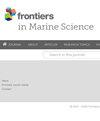Influence of microplastics on the structure and function of deep-sea communities during long-term enrichment processes
IF 2.8
2区 生物学
Q1 MARINE & FRESHWATER BIOLOGY
引用次数: 0
Abstract
Microplastics are widespread pollutants in aquatic environments, posing a significant threat to the health of marine ecosystems. However, little is known about the impact of plastics on deep-sea microbial communities. In this paper, we investigated the effects of polystyrene (PS) microplastics with three particle sizes (60 nm, 600 nm and 1 µm) and three concentrations (10, 50, 150 mg/L) as well as PS films (1 × 1 cm) on the deep-sea microbial community inoculated with water of 3370 m water depth from Pacific Ocean by using reactive oxygen species (ROS) detection, growth rate, scanning electron microscope (SEM) and high-throughput sequencing. Microplastics surface rotting (600 nm and 1 µm) and further fragmentation (60 nm) were observed caused by plastic-degrading microbial erosion after 50 days’ incubation. Similarly, deformation of PS film, including formation of obvious wrinkles and deep pits and the generation of microplastics and nanoplastics were also observed. Microplastics from commercial and plastic films could stimulate the bacterial community to secrete extracellular polymeric substance (EPS), favouring biofilm formation and resistance to external stress. Compared with larger microplastics, 60 nm microplastics and plastic films significantly inhibited the growth of bacterial communities with enhanced ROS production. The abundance of微塑料在长期富集过程中对深海群落结构和功能的影响
微塑料是水生环境中广泛存在的污染物,对海洋生态系统的健康构成重大威胁。然而,人们对塑料对深海微生物群落的影响知之甚少。本文利用活性氧检测、生长速率、扫描电子显微镜(SEM)和高通量测序技术,研究了三种粒径(60 nm、600 nm 和 1 µm)、三种浓度(10、50、150 mg/L)的聚苯乙烯(PS)微塑料以及聚苯乙烯薄膜(1 × 1 cm)对接种于太平洋 3370 米水深海水中的深海微生物群落的影响。培养 50 天后,观察到塑料降解微生物侵蚀导致微塑料表面腐烂(600 纳米和 1 微米)和进一步破碎(60 纳米)。同样,还观察到 PS 薄膜变形,包括形成明显的褶皱和深坑,以及产生微塑料和纳米塑料。来自商业薄膜和塑料薄膜的微塑料可刺激细菌群落分泌胞外聚合物(EPS),有利于生物膜的形成和抵抗外部压力。与较大的微塑料相比,60 纳米的微塑料和塑料薄膜能显著抑制细菌群落的生长,并增强 ROS 的产生。在所有添加了微塑料的富集样本中,摩拉菌科细菌的数量都占优势,而在 60 纳米微塑料和塑料薄膜富集样本中,藻胆菌科细菌的数量也有所增加,这与原位深层海水中占优势的高韦氏菌科、马林菌科、罗杆菌科和藻胆菌科细菌形成了鲜明对比。相应地,根据细菌群落结构的变化,通过 16S rRNA 基因进行功能预测,观察群落的功能变化。该研究有助于深入了解微塑料和纳米塑料对深海微生物群落的影响。
本文章由计算机程序翻译,如有差异,请以英文原文为准。
求助全文
约1分钟内获得全文
求助全文
来源期刊

Frontiers in Marine Science
Agricultural and Biological Sciences-Aquatic Science
CiteScore
5.10
自引率
16.20%
发文量
2443
审稿时长
14 weeks
期刊介绍:
Frontiers in Marine Science publishes rigorously peer-reviewed research that advances our understanding of all aspects of the environment, biology, ecosystem functioning and human interactions with the oceans. Field Chief Editor Carlos M. Duarte at King Abdullah University of Science and Technology Thuwal is supported by an outstanding Editorial Board of international researchers. This multidisciplinary open-access journal is at the forefront of disseminating and communicating scientific knowledge and impactful discoveries to researchers, academics, policy makers and the public worldwide.
With the human population predicted to reach 9 billion people by 2050, it is clear that traditional land resources will not suffice to meet the demand for food or energy, required to support high-quality livelihoods. As a result, the oceans are emerging as a source of untapped assets, with new innovative industries, such as aquaculture, marine biotechnology, marine energy and deep-sea mining growing rapidly under a new era characterized by rapid growth of a blue, ocean-based economy. The sustainability of the blue economy is closely dependent on our knowledge about how to mitigate the impacts of the multiple pressures on the ocean ecosystem associated with the increased scale and diversification of industry operations in the ocean and global human pressures on the environment. Therefore, Frontiers in Marine Science particularly welcomes the communication of research outcomes addressing ocean-based solutions for the emerging challenges, including improved forecasting and observational capacities, understanding biodiversity and ecosystem problems, locally and globally, effective management strategies to maintain ocean health, and an improved capacity to sustainably derive resources from the oceans.
 求助内容:
求助内容: 应助结果提醒方式:
应助结果提醒方式:


